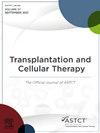Longitudinal Tear Cytokine Biomarkers: An Analysis from the Close Assessment and Testing for Chronic Graft-Versus-Host Disease (CATCH) Protocol
IF 3.6
3区 医学
Q2 HEMATOLOGY
引用次数: 0
Abstract
Background
Ocular graft-versus-host disease (oGVHD) is one of the most common initial manifestations of chronic GVHD (cGVHD) leading to significant morbidity and reduced quality of life. Early detection of oGVHD using susceptibility/risk biomarkers is urgently needed to enable preemptive therapy.
Objectives
In this subset analysis of patients enrolled on the CATCH Study (NCT04188912), we tested whether changes in tear film cytokines or ocular symptoms, as assessed by the Lee symptom scale (LSS) eye subscale, can predict oGVHD onset.
Study Design
LSS eye subscores, Inflammadry (MMP9) and conjunctival washing samples were collected before hematopoietic cell transplantation (HCT) and every 2 months (mos) until 12 mos. A custom-designed 13-plex human cytokine magnetic bead panel was used to measure: IL-10, IL-17A, IL-1Ra, IL-1α, ELA2, IL-1β, LIGHT/TNFSF14, NGAL, OSM, IL-8, IP-10, TNF-α, and VEGF-A. Cytokine levels at the pre-HCT visit were compared across the groups using the Kruskal–Wallis test. Fold change (FC) of the cytokines, defined as post-HCT value divided by pre-HCT value, was calculated and FC ≥ 2 was used in further analyses. oGVHD diagnosis was based on the NIH diagnostic criteria and having an eye score ≥1. Cox regression models were used to examine the longitudinal relationships between potential predictors and oGVHD development.
Results
Of the 44 patients included, 18 developed oGVHD, 11 had cGVHD without oGVHD, and 15 did not have any cGVHD. Median age was 64.5 years, median time from HCT to cGVHD was 6.4 mos and to oGVHD was 8.3 mos. There were no significant differences in baseline cytokine levels among groups. None of the tear cytokines or the InflammaDry MMP9 test predicted oGVHD onset. Clinically meaningful change in LSS eye score was associated with subsequent oGVHD development when compared to cGVHD without eye involvement (HR 2.5, 95% CI 1.2-5.1, P = .01); and when compared to controls (HR 3.0, 95% CI 1.4-6.0, P = .004) but the PPV of LSS change ≥15 points was low (27.6%), with a higher NPV (89.4%).
Conclusions
This is the first prospective longitudinal study of tear cytokines and symptoms in a cohort of patients observed closely through HCT for development of cGVHD. We were not able to identify any biological susceptibility/risk markers for oGVHD. Patient-reported symptoms as measured by the LSS are associated with oGVHD development but the low PPV and overlap with diagnostic criteria limit its usefulness as a biomarker to guide preemptive treatment studies.
纵向撕裂细胞因子生物标志物:来自慢性移植物vs密切评估和测试的分析。宿主病(CATCH)方案:预测眼GVHD的泪液细胞因子生物标志物。
背景:眼移植物抗宿主病(oGVHD)是慢性移植物抗宿主病(cGVHD)最常见的初始表现之一,导致显著的发病率和生活质量下降。迫切需要使用易感性/风险生物标志物早期检测oGVHD,以实现先发制人的治疗。目的:在CATCH研究(NCT04188912)患者的亚组分析中,我们测试了泪膜细胞因子的变化或眼部症状(由Lee症状量表(LSS)眼部亚量表评估)是否可以预测oGVHD的发病。研究设计:在造血细胞移植(HCT)前和每2个月(mos)至12个月收集LSS眼部亚评分、炎症(MMP9)和结膜洗涤样本。采用定制的13 plex人细胞因子磁珠检测板检测:IL-10、IL-17A、IL-1Ra、IL-1α、ELA2、IL-1β、LIGHT/TNFSF14、NGAL、OSM、IL-8、IP-10、TNF-α和VEGF-A。使用Kruskal-Wallis测试比较各组在hct前的细胞因子水平。计算细胞因子的折叠变化(FC),定义为hct后值除以hct前值,并采用FC≥2进行进一步分析。oGVHD诊断依据NIH诊断标准,且视力评分≥1。Cox回归模型用于检验潜在预测因素与oGVHD发展之间的纵向关系。结果:44例患者中,18例为oGVHD, 11例为cGVHD并无oGVHD, 15例无cGVHD。中位年龄为64.5岁,从HCT到cGVHD的中位时间为6.4个月,到oGVHD的中位时间为8.3个月。各组间基线细胞因子水平无显著差异。泪液细胞因子或InflammaDry MMP9检测均不能预测oGVHD的发病。与不累及眼部的cGVHD相比,LSS视力评分的临床意义变化与随后的oGVHD发展相关(HR 2.5, 95% CI 1.2-5.1, p=0.01);与对照组相比(HR 3.0, 95%CI 1.4 ~ 6.0, p=0.004),但LSS变化≥15点的PPV较低(27.6%),NPV较高(89.4%)。结论:这是第一个通过HCT密切观察cGVHD发展的患者队列中泪液细胞因子和症状的前瞻性纵向研究。我们无法确定oGVHD的任何生物易感性/风险标记。LSS测量的患者报告的症状与oGVHD的发展有关,但低PPV和与诊断标准的重叠限制了其作为指导预防性治疗研究的生物标志物的实用性。
本文章由计算机程序翻译,如有差异,请以英文原文为准。
求助全文
约1分钟内获得全文
求助全文
来源期刊

Transplantation and Cellular Therapy
Medicine-Hematology
CiteScore
7.00
自引率
15.60%
发文量
1061
审稿时长
51 days
 求助内容:
求助内容: 应助结果提醒方式:
应助结果提醒方式:


